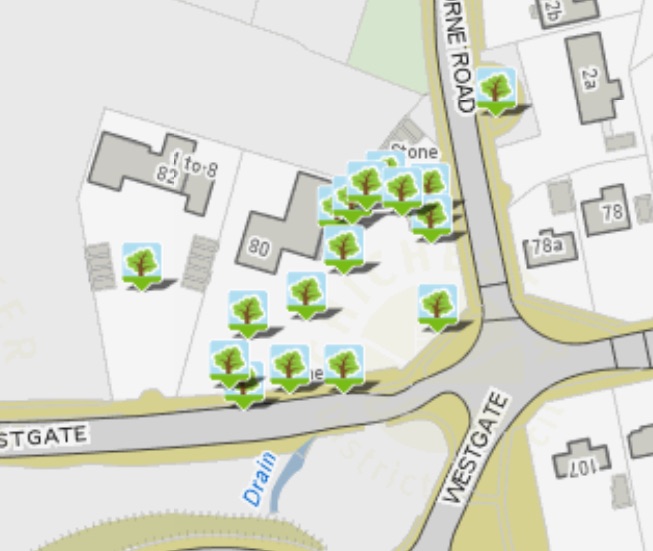Originally posted on 12 March 2016, updated on 13 June 2016. If you would like to help us keep this list up-to-date then do write in with any changes you have noticed, or join Brian Hopkins, our tree warden, on the 25th June Westgate tree walk. All tree photos are by the author unless otherwise stated.
Our protected trees
According to the CDC website, Westgate has some 30 TPO protected trees running from no 1 Henty Gardens down to no 80 Westgate. Above is a general map of where they say they should be. This part of the CDC website seems rarely to get updated so the Secretary and the Westgate Tree Warden Dr Brian Hopkins (a trained botanist), walked the street last week in preparation for the tree walk on 25 June 2016 to check the accuracy of this list. Some trees certainly seem to have disappeared from our landscape although they are still listed as being there!
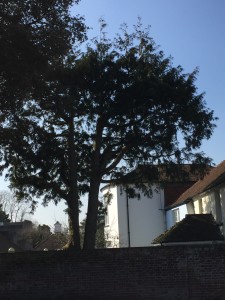
Western Red Cedar Thuja plicata
Starting from the eastern end, you will see from the above map that there are no TPO protected trees until you reach the garden of no 1 Henty Gardens. However, there is a rare Western Red Cedar with a TCA (Tree in a Conservation Area) order on it situated in the garden of no 2 The Courtyard, within the grounds of the Georgian Priory, the former Theological College. This species of tree is the national tree of British Columbia and grows very tall in the wild. Our specimen has had its height severely restricted by pollarding, no doubt for light purposes, but this has rather destroyed its natural shape and it is now overshadowed by a larger holm oak next to it, which are two a penny in Chichester.
At the mouth of Henty Gardens in the solicitor’s grounds, may be found, unlisted, two flowering cherries (prunus) one of which is upright. It will take some time to identify which botanical name either holds.
Significant Tree Group at Mercers
Actual TPOs as shown on the above map are to be found within the grounds of Mercers at 52 Westgate (the old brewery). Here are listed some 8 protected trees under the same 1962 order: 62/135. The cluster to the right of the street entrance is mentioned as a Significant Tree Group in the Chichester Conservation Area Character Appraisal (CCACA) but seems to have disappeared altogether, apart from the horse chestnut (T1) in the grounds of no 1 Henty Gardens. There were once two more chestnuts and an acacia here, since removed.
London Plane 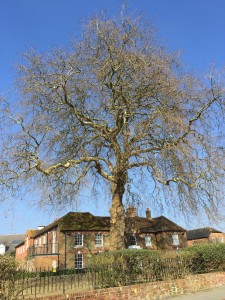 Platanus acerifolia
Platanus acerifolia
Walking or driving by, you will have noticed that slightly to the left and in front of Westgate House stands the magnificent London Plane (T4) which has been regularly pollarded with permission (in 2003, 2005 and 2008). It is very difficult ageing a tree without cutting it down. Although not as old as those in Green Park London this one could be over 120 years old and is a key feature of our streetscape.
Three more trees may be seen at the top of the map near the Parklands doctors’ surgery. The one nearest to their boundary is a cork oak (T1) which we found in the Mercers car park, a small specimen somewhat overshadowed by conifers, but definitely there. Cork in Westgate! The one below was a Turkey Oak (T2) which appears to have been felled with permission in 2010, still being pruned in 2005 and 2008, and sure enough a large dead trunk still stands there. To the right of it is another oak, still standing. Also within the southern boundary are a large unlisted Leyland Cypress Hedge and a Monterey Cypress, which were last pruned in 2003: there is some concern that these could be affected by the honey fungus in the chestnut on the corner of Parklands Road (see below).
We also discovered there is a healthy beech tree to the front of the grounds at Mercers’ and which will form a handsome focus when it is a little larger, now that the dying Horse Chestnut on the corner of Parlkands Road has been removed.
The “Powell & Moya” Trees
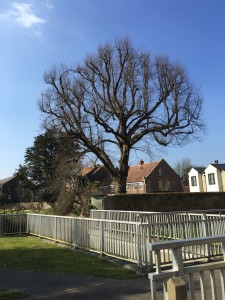 Out walking to the station, you will have noticed to the south of the houses in Mount Lane and St Bartholomew Close, alongside the Lavant, are two fabulous mature trees. These mark the southern limit of a large plot of land upon which the distinguished local architect Sir Philip Powell together with his partner Hidalgo Moya designed (1943) and built (1949) two Modernist bungalows, the original no 1 Mount Lane for his father, Canon Arnold Powell, and the original no 2 Mount Lane for his sister and her husband. These houses can still be seen on early versions of the Google satellite map, but were demolished respectively in 2003 and 2008 in spite of a local campaign to keep them. Powell and Moya went on to put up the Skylon for the 1951 Festival of Britain and are well known in Chichester of course as the architects some 13 years later of the Chichester Festival Theatre.
Out walking to the station, you will have noticed to the south of the houses in Mount Lane and St Bartholomew Close, alongside the Lavant, are two fabulous mature trees. These mark the southern limit of a large plot of land upon which the distinguished local architect Sir Philip Powell together with his partner Hidalgo Moya designed (1943) and built (1949) two Modernist bungalows, the original no 1 Mount Lane for his father, Canon Arnold Powell, and the original no 2 Mount Lane for his sister and her husband. These houses can still be seen on early versions of the Google satellite map, but were demolished respectively in 2003 and 2008 in spite of a local campaign to keep them. Powell and Moya went on to put up the Skylon for the 1951 Festival of Britain and are well known in Chichester of course as the architects some 13 years later of the Chichester Festival Theatre.
Interestingly the tree legacy of this site remains. The tree to the south of the new no 1 Mount Lane is a Lime, seen above, protected since 2011 (TPO 11/045) and pruned in 2014. The one south of the flats in St Bartholomew Close is protected unusually in our street as a group of trees and since only 2014 (TPO 14/063) . Within the grounds of what is now St Bartholomew Close is another Monterey Cypress protected since 2003 (TPO 03/349). There seems to have been a third, unprotected, on the opposite side of Mount Lane in the grounds of Marriott Lodge but no longer visible.
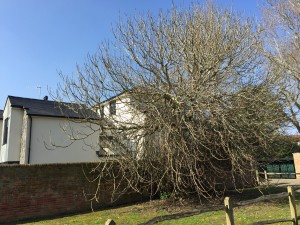
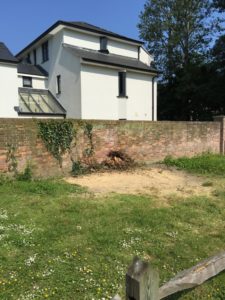
The sprawling Brown Turkey fig tree alongside the wall of no 1 Mount Lane did not have a TPO but it was clearly ancient and protected by dint of being in the Conservation Area. However this has proved NO protection, as it was recently felled (early June 2016) by someone who seems to have deemed it unsafe after recent strong winds. This kind of unilateral action is not supposed to happen and residents have made a complaint to the tree officer at the District Council.
Inside this gated community however may be found two very ancient espalier trained apple trees. These huge gnarled fruit trees must predate the development by many years and are being carefully maintained by the current owners.
The trees that run along the Mount Lane side of no 27 Westgate are mentioned as a significant tree groupin the 2016 Chichester Conservation Area Character Appraisal (CCACA), including a handsome pair of poplars. This area has recently been cleaned up and restored to its former glory thanks to local residents.
Cedar of Lebanon Cedrus libani
At the junction of Mount Lane with Westgate, the very handsome Cedar of Lebanon in the churchyard of St Bartholomew Without is another key tree in our streetscape, currently unprotected by a TPO but part of yet another Significant Tree Group in the 2016 CCACA.
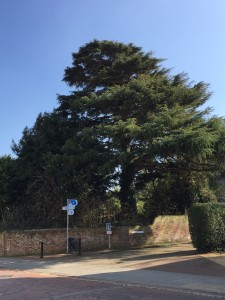 Given that it is on cathedral land, perhaps there is no need to protect it?
Given that it is on cathedral land, perhaps there is no need to protect it?
The Tree of Heaven Ailanthus altissima
Many residents will be aware of the Tree of Heaven (Ailanthus altissima) in the garden of no 27 Westgate, some not all for the best of reasons, since this North China tree often colonises by suckering. Fortunately our climate is less clement than in its native environment, so it is not quite as out of control here as it could be; contrary to the warmer parts of the US where it is known as an invasive exotic plant.
In those warmer parts, Tree-of-Heaven as they call it, is a deciduous tree that may reach 80 feet in height and 6 feet in diameter (ours far exceeds that girth, see below). These trees have odd or even pinnately compound leaves that have 10 to 41 leaflets on 1 to 3 foot stalks. When crushed, the leaves have a strong odour the Americans find resembles peanut butter. The bark is usually light gray and rough. Yellowish-green flowers appear on 20 inch long terminal clusters in April to June. Wing-shaped fruit appears from July to February.
 In the US climate, Tree-of-Heaven is a rapidly growing tree that colonizes by root sprouts and seeds that are spread by wind and water. Sprouts can grow 10 to 14 feet in their first year and seedlings can grow 3 to 6 feet. Viable seeds are present already on 2 to 3 year old trees. Tree-of Heaven is shade and flood intolerant and few wildlife species make use of it. Interestingly, kestrels fight it out with the grey squirrel to nest in ours! The tree was introduced to the US as an ornamental but is planted rarely these days.
In the US climate, Tree-of-Heaven is a rapidly growing tree that colonizes by root sprouts and seeds that are spread by wind and water. Sprouts can grow 10 to 14 feet in their first year and seedlings can grow 3 to 6 feet. Viable seeds are present already on 2 to 3 year old trees. Tree-of Heaven is shade and flood intolerant and few wildlife species make use of it. Interestingly, kestrels fight it out with the grey squirrel to nest in ours! The tree was introduced to the US as an ornamental but is planted rarely these days.
In the UK, it was introduced from China in 1751 and is frequently planted since our climate does keep this tree’s excesses in check. There are several in our area, most notably outside County Hall and in Tangmere. Ailanthus are fast-growing deciduous trees in the UK all the same, grown mainly for their strikingly large, pinnate leaves. Here, A. altissima is a spreading tree, often suckering, with large pinnate leaves which are reddish in spring, and small green flower clusters followed on female trees by red, winged fruits. The leaves have up to 30 leaflets arranged in pairs along a common stalk. The trees of this species are unisexual. Most in Britain are female, but the one outside the back of Edes House at County Hall on West Street is male yet has much-branched clusters of small greenish flowers in summer.
National Girth Champion
But that is not all. Did you know that in this tree, Westgate possesses the national girth champion of the British Isles (UK and Ireland combined)? The girth of the Tree of Heaven at 27 Westgate was measured in 1997 by Nigel Muir, as 4.60m at a height of 1.50m (The Tree Register (Nigel Muir) 1997). Since then the tree has continued to grow and still looks very luxuriant. Its overall height is not known. It is catalogued as number 14989 in the monumentaltrees.com register. Take a look.
Disappearing Trees
There is mounting concern that age, coupled with the spate of large tree diseases to hit the UK since last century, is leading to the disappearance from our urban landscapes of all those majestic trees that the Victorians left us with and which are now very mature. We have written about this before and Westgate is not exempt from this problem.
- Honey Fungus Armillaria mellea
On the corner of Parklands Road lies the final Significant Tree Group recorded for Westgate by the CCACA. Here were two handsome horse chestnuts, one of which was felled and replaced in 2003. Neither were protected by a TPO in spite of their nomination as an STG. The second one finally disappeared in May 2016, both having been affected by honey fungus (Armillaria melee) and felled by WSCCC Highways with permission. Honey fungus can travel up to 30m to infect nearby trees, and tree wardens are concerned for the two holm oaks in this STG group which flank the entrance to Parklands Road, although they seem to have perked up quite a bit since the removal of the infected tree.
- Elm Ulmus minor
In the garden of no 56 Westgate, a large elm is marked by the CDC, protected since 1960 by TPO 60/132. Elms are rare since Dutch Elm disease carried so many off towards the end of last century, and this one is no longer there for sure.
The Tannery
On the western side of the entrance to The Tannery, stands an ash Fraxinus excelsior, protected since 2007 by TPO 07/181. This date is significant since Ash is currently under attack from the chronic fungal disease known as ash dieback (hymenoscyphus fraxineus), which was first identified in 2006. There is some debate that this might have survived as it is perhaps not the native species – look at the bark.
Immediately to the south of it, on the same side of the street, is a Horse Chestnut Aesculus hippocastanum, protected since 2009 by TPO 09/129. Horse Chestnut is also under attack, from horse Chestnut Leaf Miner, a small moth which lays eggs inside the leaves. There are several along Westgate and the effect of this infestation on our Autumns has generally become vast and truly saddening. However we are happy to report that this particular tree is being well looked after by the residents of The Tannery and appears to be in rude health.
Attacks of leaf miner don’t kill horse chestnuts on their own, but do leave them prey to other diseases. Among these is bleeding canker, seen on sections of dying bark, which oozes a gummy substance. Clear at first, it turns rusty brown and finally black. Ultimately the tree can die. Attacks by the leaf miner could be why the horse chestnuts to the north of the street have succumbed to honey fungus.
It is worth bearing in mind that Horse Chestnuts are not themselves native trees, strictly speaking. Originating in fact in Turkey, although they have been with us a long time, the first were planted around the time of the Spanish Armada.
Unprotected trees
Other important trees in our streetscape that are unprotected as yet are, at no 62 Westgate, a big birch, and at no 64 a handsome Deodar Cedar Cedrus deodara, which has been braced. At no 70 is a handsome lime and at 72 a sweet chestnut and a variegated maple. In the garden of no 72a stands a striking blue-grey cedar tree, a Cedar atlanticum glaucum.
A rarity: a female Gingko Biloba
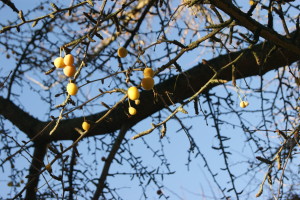
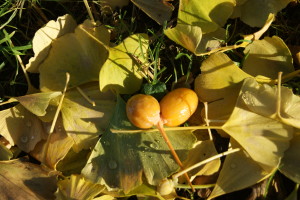
In the garden of no 74 Westgate may be found Westgate’s other great tree rarity: a female Gingko biloba.
This very early tree, fossils of which have been found in West Sussex, so it may be considered native since time immemorial, is rarely planted in its female guise.
However Westgate has got one, in the grounds of the old rectory, and here are some photos of the fruits, rarely seen in the UK.
In the grounds of 74 may also be found another Cedar atlanticum glaucoma, an unknown conifer, a hornbeam hedge and a thriving walnut tree.
In the grounds of no 76, someone had the foresight to plant a male gingko in the adjoining garden which is why this one has flowered. An old air raid shelter is still standing there too.
In the grounds of At 76a may be seen a handsome bamboo hedge along the eastern boundary and a large lime is growing at no 78a.
On the odd numbered side of the road there are four copper beeches, one each pollarded at nos 99 and 103 and then a tall pair, wonderfully untouched, in the grounds of no 107 on the corner of the roundabout.
No 80 Westgate
In one of the oldest properties on the street, the grounds of no 80 Westgate contain an extraordinary collection of some 15 trees, all protected since 1970 by TPO 70/223, perhaps the date when the conversion of this house into flats began.
Quite how many of these trees are still standing will also require some further investigation. First, there is the willow (T12) by the gate at the roundabout. Along the north side of Westgate, past the roundabout, lie a beech (T4), a Judas Tree (T9), a Hawthorn (T10) and a Lime (T14).
To the north of these boundary trees lie another ten TPOs running from South West to North East. Apart from double examples of the usual British trees, Ash (T13, T7), Horse Chestnut (T1, T15) and Lime (T2, T16), this group contains interesting specimens such as a Maple (T6), a Magnolia (T8), a Bay (T3) and a Clerodendrum (T11), otherwise known as the Glorybower (see photo below).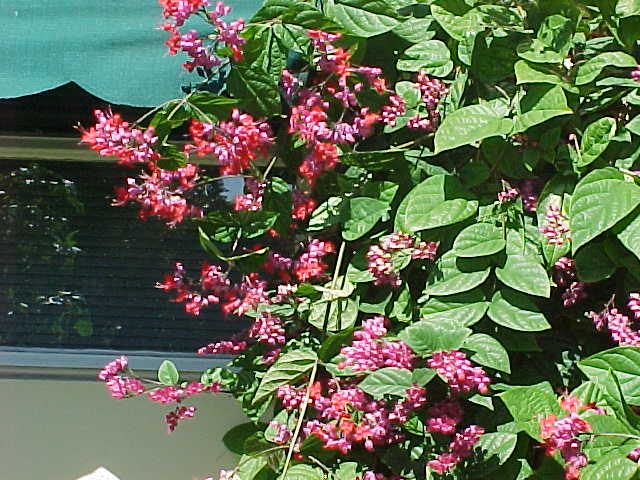
82 Westgate
And finally, in the grounds of this property and protected by the same 1970s TPO as no 80, sits a handsome cedar (T5).
The Westgate Spring Tree Walk
If you are interested in our local trees, then why not join us on 25 June 2016 as part of our social programme, when we walk down Westgate with our Tree Warden, Dr Brian Hopkins of Henty Gardens, to check on the catalogue of our protected trees and update it?
If you have a general interest in the trees of Chichester then download the Chichester tree trail and take a walk round this City of Trees. Chichester is a very leafy city and there are a few hundred trees within its walls; the tree trail has been devised to introduce both residents and visitors to some of the interesting ones. The trail is about one-and-a-half miles long and takes about an hour-and-a-half to complete.
Sources:

